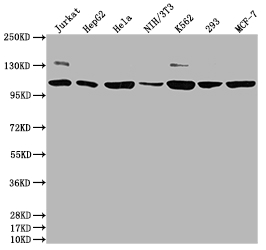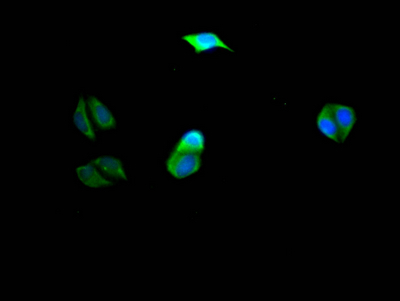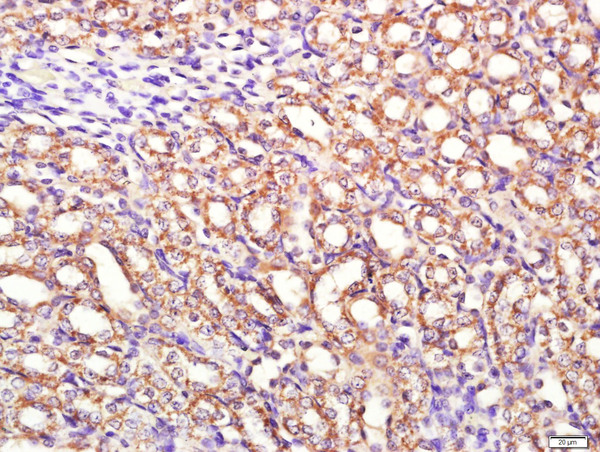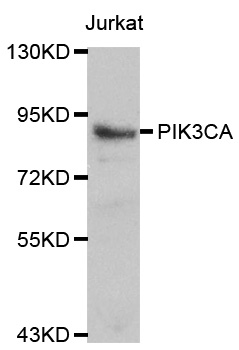
Western Blot Positive WB detected in: Jurkat whole cell lysate, HepG2 whole cell lysate, Hela whole cell lysate, NIH/3T3 whole cell lysate, K562 whole cell lysate, 293 whole cell lysate, MCF-7 whole cell lysate All lanes: PIK3CA antibody at 1:1500 Secondary Goat polyclonal to rabbit IgG at 1/50000 dilution Predicted band size: 125 kDa Observed band size: 110 kDa
PIK3CA Recombinant Monoclonal Antibody
CSB-RA578819A0HU
ApplicationsImmunoFluorescence, Western Blot, ELISA
Product group Antibodies
ReactivityHuman, Mouse
TargetPIK3CA
Overview
- SupplierCusabio
- Product NamePIK3CA Recombinant Monoclonal Antibody
- Delivery Days Customer20
- ApplicationsImmunoFluorescence, Western Blot, ELISA
- CertificationResearch Use Only
- ClonalityMonoclonal
- Clone ID10E5
- ConjugateUnconjugated
- Gene ID5290
- Target namePIK3CA
- Target descriptionphosphatidylinositol-4,5-bisphosphate 3-kinase catalytic subunit alpha
- Target synonymsCCM4, CLAPO, CLOVE, CWS5, HMH, MCAP, MCM, MCMTC, PI3K, PI3K-alpha, p110-alpha, phosphatidylinositol 4,5-bisphosphate 3-kinase catalytic subunit alpha isoform, PI3-kinase p110 subunit alpha, mutant phosphatidylinositol-4,5-bisphosphate 3-kinase catalytic subunit alpha, phosphatidylinositol 3-kinase, catalytic, 110-KD, alpha, phosphatidylinositol 3-kinase, catalytic, alpha polypeptide, phosphatidylinositol-4,5-bisphosphate 3-kinase 110 kDa catalytic subunit alpha, phosphoinositide 3-kinase alpha, phosphoinositide-3-kinase, catalytic, alpha polypeptide, ptdIns-3-kinase subunit p110-alpha, serine/threonine protein kinase PIK3CA
- IsotypeIgG
- Protein IDP42336
- Protein NamePhosphatidylinositol 4,5-bisphosphate 3-kinase catalytic subunit alpha isoform
- Scientific DescriptionPhosphoinositide-3-kinase (PI3K) that phosphorylates PtdIns (Phosphatidylinositol), PtdIns4P (Phosphatidylinositol 4-phosphate) and PtdIns(4,5)P2 (Phosphatidylinositol 4,5-bisphosphate) to generate phosphatidylinositol 3,4,5-trisphosphate (PIP3). PIP3 plays a key role by recruiting PH domain-containing proteins to the membrane, including AKT1 and PDPK1, activating signaling cascades involved in cell growth, survival, proliferation, motility and morphology. Participates in cellular signaling in response to various growth factors. Involved in the activation of AKT1 upon stimulation by receptor tyrosine kinases ligands such as EGF, insulin, IGF1, VEGFA and PDGF. Involved in signaling via insulin-receptor substrate (IRS) proteins. Essential in endothelial cell migration during vascular development through VEGFA signaling, possibly by regulating RhoA activity. Required for lymphatic vasculature development, possibly by binding to RAS and by activation by EGF and FGF2, but not by PDGF. Regulates invadopodia formation through the PDPK1-AKT1 pathway. Participates in cardiomyogenesis in embryonic stem cells through a AKT1 pathway. Participates in vasculogenesis in embryonic stem cells through PDK1 and protein kinase C pathway. Also has serine-protein kinase activity: phosphorylates PIK3R1 (p85alpha regulatory subunit), EIF4EBP1 and HRAS. Plays a role in the positive regulation of phagocytosis and pinocytosis (By similarity).
- ReactivityHuman, Mouse
- Storage Instruction-20°C or -80°C
- UNSPSC41116161







